Dear Dr. SerVaas:
I am writing to see if you or any of your readers know of anything that will help interstitial cystitis. I have a very dear relative who has this affliction and has suffered excruciating pain for many years. Her doctors have told her they do not know the cause nor the cure. She has learned that eating foods that are less acidic has helped some. However, the pain is exhausting. I thought perhaps you or some of your readers may have had some experience that would be helpful.
Mrs. Martin Zacha
Texarkana, Texas
For years, the late Dr. William Crook worked with Indianapolis urologist Dr. Phillip Mosbaugh to investigate whether the common yeast Candida albicans plays a role in interstitial cystitis (IC). At the time, it was quite unusual for a mainstream urologist like Dr. Mosbaugh to support such an unconventional theory.
In a 1998 pilot study, 15 patients with severe IC symptoms eliminated all sugars, wheat, yeast, beer, and al cohol from their diets and were given Diflucan (fluconazole) for treating systemic yeast infections. Although the diet was difficult to follow, six patients reported dramatic improvement and lapsed back to prior symptoms when the diet was gradually liberalized. Another six in the study were somewhat better, and three were unimproved.
"Expanded interest and research over the past 20 years has resulted in much greater awareness of interstitial cystitis, as well as more confidence and assurance in the diagnosis and better therapies," says Dr. Mosbaugh. We are sending you his summary of commonly used drug, dietary, and surgical strategies. If other readers would like to receive this information, please send a self addressed, stamped envelope to: "Medical Mailbox," Attn.: Cystitis.
Chelation for Chronic Pain
In the Mar./Apr. "Medical Mailbox," reader Byron King of Sonoma, California, requested information on using IV chelation for nondiabetic peripheral neuropathy (PN), adding that nearly every source of information he could locate is related to diabetics with the condition.
We asked Dr. Dale Guyer, a physician who utilizes complementary therapies in his clinical practice, to share his experiences with treating nondiabetic PN. His reply:
"I have observed good results with chelation therapy for nondiabetic peripheral neuropathy. In general, standard courses of chelation include 20 to 30 treatments. Improvement is often noted following 10 to 12 treatments, after which a maintenance program is advised.
"Optimum improvement is achieved when chelation is used synergistically with additional therapies. For example, I have seen excellent results with high-dose (about 10 mg daily) biotin supplementation. Acetyl 1-carnitine and good old-fashioned [B.sub.12] shots may also be beneficial.
"A good option for pain control--especially in light of the recent problems with systemic pain medicines--is pleuronic lecithin organogel (PLO gel). This is a prescription product that is manufactured by a compounding pharmacy. Anti-inflammatory agents can be mixed into the gel and rubbed on painful sites. The gel creates high levels of pain relief without being absorbed appreciably into the bloodstream. As a result, the compounded gel has no side effects for the most part. I have prescribed it for many patients, and they refer to it as "wonder' gel."
Dr. Guyer is currently participating in the NIH-funded study to test the effectiveness of chelation for coronary heart disease. See page 74 for more on the ongoing research.
COPYRIGHT 2005 Saturday Evening Post Society
COPYRIGHT 2005 Gale Group



